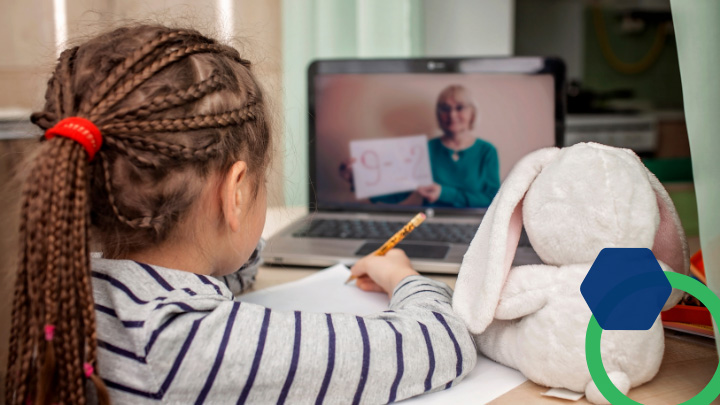Student-centered learning thrives on strong student-teacher relationships. As a BetterLesson coach, I have heard from teachers and administrators this fall about how difficult it is to form relationships and thus foster student engagement during remote learning.
As I work with teachers and administrators to address these challenges, it’s not surprising that the coaching process mimics the best teaching practices: assessing the individual’s situation, identifying goals to work towards, implementing strategies to achieve the goals, and reflecting on that progress. At BetterLesson, we refer to this as the Try-Measure-Learn cycle. Here is one case study:
First Coaching Meeting
Dan (not his real name) is a world language teacher who has spent most of his long career teaching face to face in classrooms around the world. The authentic hands-on learning environment he had created in his classrooms was honed from years of practice, allowing him to forge strong connections with students. Then the pandemic hit, and he found himself in a new role at a new school using a digital format that he had never worked with before. He struggled to keep students engaged. They did not turn in work. They did not show up to synchronous classes. If they did attend, they did not turn on cameras or communicate very much. As a new teacher in the district, Dan did not have strong connections to students or colleagues.
In our first coaching meeting, Dan shared his struggles with technology, learning the protocols of a new school system, and a sense of overwhelm that the tools in his veteran teacher tool belt were not sufficient to meet the students’ learning needs at this moment. As we talked, we drilled down to the foundation of good teaching: a desire to connect with students, to give them a space to engage and be heard, and to support their learning journey. Dan wanted all of these things, but he needed a few new tools.
Dan’s goal was to increase his students’ attendance and engagement in his online classes. Knowing that having a solid student-teacher connection will lead to greater student motivation and engagement, Dan knew he had to strengthen this area first.
Try Phase
I recommended that Dan try the I Wish My Teacher Knew strategy to engage his students in conversation about their lives and interests and foster stronger relationships in his classroom. He chose to create a Google form survey that students could complete about every two weeks. He would vary the questions each time, to adapt to the ongoing instruction and provide some variety for students. By creating this digital form, students could answer it outside of class time. The questions were low-stakes and not tied to a grade.
His first iteration included general questions, such as what interests they had, what classes students liked the most and the least, and any other general information the student wanted Dan to know. When we met two weeks later, we examined the responses from the survey.
- One student shared that Dan had been pronouncing her name wrong, and provided him with the correct pronunciation.
- A student shared that her ‘easiest’ class was one that did not provide a lot of homework. She explained that it was hard for her to complete homework because she had to watch her younger siblings after the online school day when her parents were at work.
- Some students shared their struggles with logging into a class or having weak wifi connections that caused their computers to freeze frequently.
Measure Phase
Dan realized that he had received many forms from students who had not been attending class regularly. In fact, this response was in some cases the first extended ‘conversation’ he had had with some students since the start of the year. From a quantity point of view, he succeeded in connecting with more students overall. For students who did not reply to the survey, Dan made a note to reach out personally via email or phone to check-in. From a quality point of view, examining the individual responses, as noted above, provided a great example of what he learned from this strategy.
Learn Phase
The responses to his first survey were varied, reflecting the individual circumstances and needs of his students. Considering the responses allowed Dan to take targeted actions to personalize his approach to connecting with students.
- When Dan learned that he had mispronounced a student’s name, he was both embarrassed and relieved to have this information. He felt bad for mispronouncing her name but now had the knowledge to remedy the situation. In doing so, he demonstrated his responsiveness to a student’s needs and created a classroom in which the student had a stronger sense of belonging.
- When students did not complete homework, Dan had assumed it was because they did not prioritize his class or that they were not hard-working. In considering the response to his survey, he realized that his perspective was flawed. The lived experience of this student, at this moment, showed some of the family pressures that existed, allowing Dan to shift his perspective and acknowledge the student’s situation from a place of compassion and empathy.
- Dan was able to connect students who had tech struggles to the technology staff at school to improve their access.
Reflection
Not only did Dan’s survey illuminate his understanding of his students’ lives, but he also shared at our next coaching meeting that more students were attending class regularly now. He had used some of the class time to share his own struggles with technology, and let students know they weren’t alone. The dynamic of the online classroom changed as well. Rather than students listening silently with cameras off while he presented a lesson, students talked with each other, troubleshooting some tech troubles and offering each other support and encouragement in managing the online platform. While these interactions were brief at the start of class, they created a classroom community of support and engagement.
Try-Measure-Learn Cycle #2…and Beyond
Dan’s weekly surveys have shifted a bit to include more questions relating to instruction. He has heard from students who feel that the pace of the class is going too quickly…or too slowly! Even with differing viewpoints, Dan is able to track which students are struggling and why. This allows him to adjust his assignments and planning to include opportunities for students to demonstrate progress at a more flexible pace.
Dan’s goal was to achieve greater student engagement in his online classes, and he is making progress towards that goal by developing stronger connections to his students. They are open with him about their struggles and he is responsive in his planning and support. In addition to these goals, Dan has also gained greater confidence in using digital tools in his instruction. He has branched out from Google forms to using Google sheets for tracking student progress, allowing him to connect with colleagues and support services more easily using shared data. Next up, he is using embedded audio in Google slides to support the flexible assessment of speaking activities in class.
The student-teacher connections that are forged in the classroom not only support student growth. They help teachers move forward with confidence in knowing that their teaching is meeting students’ needs more precisely. As we all navigate this evolving landscape in education, the strength of relationships is key in keeping us connected in the digital classroom.








